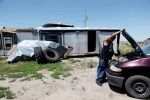A Snapshot of Pine Ridge

Drive south on Route 41 through the Pine Ridge res-ervation in South Dakota and you’ll see a vast basin filled with porous mounds of dirt called the Badlands. To the east, the Black Hills into which Mt. Rushmore, a sacrilege to the Lakota, is carved. If you continue south you’ll find something like a desert – a dry, rolling landscape marked with the occasional stream or clump of trees.
This is where one of the Colgate COVE trips ven-tured over spring break. Nine of us spent the week with an organization called Re-member, which coordinates service work projects but also manufactures “on the rez” experiences through a bit of gift shop tourism.
Houses are pretty discrete on the reservation. They stand maybe a quarter mile from each other. Most are trailers; some are smaller. Five or six broken-down vehicles might surround the house. Most parts are missing because they’ve been sold for what little money they’re worth.
From the road, Pine Ridge looks pretty desolate, but walk into a home and you’ll find up to 20 people living in three or four rooms. It’s common to have four people sleeping in the same bed. About 30,000 people live in Pine Ridge, which, geographically, is about the size of Connecticut.
The lack of housing makes sense: there is no infrastructure on the reservation. Ac-cording to backpacksforpineridge.com, the unemployment rate floats between 83 and 85 percent. The only jobs are in education and in the tribal government, which is often infected with nepotism.
There’s a Taco John’s too, a Subway, a Pizza Hut and a small convenience store called Big Bats in the town of Pine Ridge. They might add another 50 jobs.
Life is pretty bleak. There isn’t too much to do without any jobs. Houses are so spread out that it makes more sense to stay at home. Many be-come alcoholics, and according to the same source, more than 50 percent of families are affected by alcoholism even though the reservation is technically dry. The town of Whiteclay, Nebraska, which is about a third the size of downtown Hamilton, supplies much of the alcohol. It’s only two miles from the town of Pine Ridge, which sits right on the southern border of South Dakota. In-dians either walk or drive to one of the three stores, all owned by whites, to buy beer. The most popular drink is the Budweiser Hurricane – a 24-ounce lager with 8.1 percent alcohol.
Outside of these stores are intoxicated Indians, many slumped over and some unconscious. Others sit in groups. Police cars roll slowly through the intersection, stopping every once in a while to arrest somebody.
It’s hard for kids who see only dead ends. Not only are their parents crippled by a dependence on alcohol, they also often face physical and sexual abuse. According to backpacksforpineridge.com, the teen suicide rate is 150 percent higher than the U.S. average for this age group.
Many join gangs later on. The American Indian Move-ment (AIM) used to be the outlet for much of the anger Indians felt toward the American government. Activism like the occupation of the Bureau of Indian Affairs (BIA) or the take-over of Wounded Knee in 1973 has dissipated. Young Indians have nothing like that now. AIM was dis-mantled in the 1980s. Gangs subsequently formed and now define life on the reservation. Many don’t know that the reservation was, in fact, a prisoner-of-war camp. Its code was 344. Not much has changed since then.
The boundaries are still the same. Indians can leave now of course. But that changes nothing in Pine Ridge. The conditions are the same. Not many Indians leave, because of the culture shock and racism, and also because escaping means leaving your family behind and know-ing how vulnerable they are. Driving back north and off the reservation toward Rapid City, you’ll start to see more green. You’ll see large pastures and cows and horses – many more than you had seen on the reservation. You’ll see bigger houses and nice trucks. You’ll appreciate smooth, paved roads.
These are American ranches, land that was confiscated from Indians in the Dawes Act and turned over to whites. This is typical. The owners of the liquor stores in White-clay, who sell 4.5 million cans of beer every year, are also white. Those who work for the BIA are white too. It’s a 20 minute car ride to get from these subsidized and fertilized plots to the arid soil on which Indians live in Pine Ridge, separated by the chasm called the Badlands.
Contact Thomas Hedges at [email protected].








